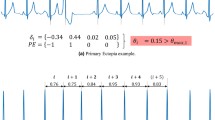Abstract
The Marburg Cardiomyopathy Study (MACAS) is a prospective observational study designed to determine the value of the following potential non-invasive arrhythmia risk predictors in more than 200 patients with idiopathic dilated cardiomyopathy (IDC) over a 5-year-follow-up period: New York Heart Association functional class, left ventricular end-diastolic diameter and ejection fraction, left bundle branch block and atrial fibrillation on ECG, QTc and JTc-dispersion on 12-lead ECG, abnormal time-domain analysis and spectral turbulence analysis of the signal-averaged ECG, ventricular arrhythmias and heart-rate variability on 24-hour Holter ECG, baroreflex sensitivity, and microvolt T wave alternans during exercise.
This report describes the rationale of MACAS as well as the clinical characteristics of the first 236 patients enrolled between March 1996 and October 1999. The prognostic significance of the potential arrhythmia risk predictors in MACAS will be determined by multivariate Cox analysis at the end of 5-year follow-up. Primary endpoints are total mortality and major arrhythmic events defined as sustained ventricular tachycardia, ventricular fibrillation or sudden cardiac death.
The results of MACAS will have important implications for the design of future studies evaluating the role of prophylactic defibrillator therapy in idiopathic dilated cardiomyopathy.
Zusammenfassung
Die Marburger Kardiomyopathie-Studie (MACAS) wurde als prospektive Verlaufsbeobachtung konzipiert, um die Wertigkeit der folgenden potentiellen nichtinvasiven Arrhythmieprädiktoren bei über 200 Patienten mit dilatativer Kardiomyopathie (DCM) im Verlauf von fünf Jahren zu untersuchen: Stadium der Herzinsuffizienz nach der Klassifikation der New York Heart Association, linksventrikulärer enddiastolischer Diameter und Ejektionsfraktion, Linksschenkelblock und Vorhofflimmern im EKG, QTc- und JTc-Dispersion, abnormale Time-domain-Analyse und spektrale Turbulenzanalyse des signalgemittelten EKG, ventrikuläre Arrhythmien und Herzfrequenzvariabilität im 24-Stunden-Langzeit-EKG, Baroreflexsensitivität und Mikrovolt-T-Wellen-Alternans unter Belastung.
Dieser Bericht beschreibt die Grundlagen von MACAS sowie die klinischen Charakteristika der ersten 236 Patienten, die von März 1996 bis Oktober 1999 eingeschlossen wurden. Die prognostische Bedeutung der potentiellen Arrhythmierisikoprä,diktoren in MACAS wird durch eine multivariate Cox-Analyse nach einem Verlauf von fünf Jahren bestimmt. Primäre Endpunkte sind die Gesamtmortalität und schwerwiegende arrhythmische Ereignisse, definiert als anhaltende Kammertachykardie, Kammerflimmern oder plötzlicher Herztod.
Die Ergebnisse von MACAS werden wichtige Erkenntnisse liefern für die Konzeption zukünftiger Studien zur prophylaktischen Defibrillatortherapie bei dilatativer Kardiomyopathie.
Similar content being viewed by others
Author information
Authors and Affiliations
Additional information
Rights and permissions
About this article
Cite this article
Grimm, W., Hoffmann, J., Menz, V. et al. Prediction of Major Arrhythmic Events and Sudden Cardiac Death in Dilated Cardiomyopathy The Marburg Cardiomyopathy Study Design and Description of Baseline Clinical Characteristics. Herz 25, 189–199 (2000). https://doi.org/10.1007/s000590050006
Issue Date:
DOI: https://doi.org/10.1007/s000590050006




